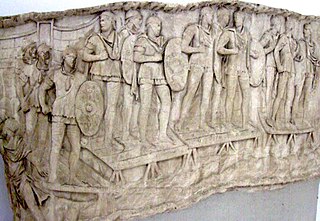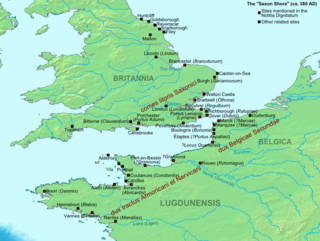Critique
Luttwak's work has been praised for its lucid analysis of, and insights into, issues regarding Roman military dispositions, and for stimulating much scholarly debate about these issues. [8] But the validity of his basic thesis has been strongly disputed by a number of scholars, especially in a powerful critique by B. Isaac, the author of the fundamental study of the Roman army in the East (1992). [9] The objections fall under two broad headings: (1) The Roman empire did not have the intelligence and planning capacity to sustain a "grand strategy" and in any case was not defensive in ideology or policy. [10] (2) Defence-in-depth is not, in the main, consistent with the literary and archaeological evidence. [11]
Strategic planning
Luttwak's thesis of an imperial grand strategy rests on a number of assumptions: (a) that the empire's strategic posture was basically defensive; (b) that Roman expansion and choice of borders were systematic and rational, with the main objective of securing defensible borders; (c) that the Roman government's primary concern was to ensure the security of its provincial subjects. But Isaac demonstrates that these assumptions are probably false and result from inappropriate application of modern concepts of international relations and military strategy to the ancient world. [12] Isaac suggests that the empire was fundamentally aggressive both in ideology and military posture, up to and including the fourth century. This was demonstrated by the continued military operations and siting of fortifications well beyond the imperial borders. [13] The empire's expansion was determined mostly by the ambitions of emperors; and that the choice of borders, to the extent that they were planned at all, was more influenced by logistical considerations (e.g. rivers, that were critical conduits for supplies) rather than defensibility. Finally, the imperial government probably was far less concerned with the security of its subjects than would be a modern government. [14] Isaac shows that the empire did not develop the centralised military planning, or even accurate enough cartography, necessary to support grand strategy. Rome did not develop the equivalent of the centralised general staff of a modern army (and even less strategic studies institutes of the kind frequented by Luttwak). Emperors depended on the theatre military commanders (the provincial governors, later the magistri militum and duces) for all military intelligence. [15]
Archaeological evidence
There is also little unequivocal archaeological and literary evidence to support defence-in-depth. [11] Luttwak's defence-in-depth hypothesis appears to rely on two basic features: (a) deepened fortified border zones: "It became necessary to build forts capable of sustained resistance, and these fortifications had to be built in depth, in order to protect internal lines of communication. Instead of a thin perimeter line on the edges of provincial territory, broad zones of military control had to be created..." [16] "The thin line of auxiliary 'forts' and legionary 'fortresses' was gradually replaced by a much broader network of small fortified hard-points (in the hands of) scattered groups of static limitanei..." [17] The hypothesis thus predicts the establishment of fortifications well into the interior of border provinces, rather than just a string of bases right on the border line; (b) the use of the comitatus praesentales (imperial escort armies) as interception forces to deal with incursions. Luttwak terminates his analysis in 350, before the establishment of the regional comitatus. The interception forces were thus the single large comitatus of Constantine, and, later, the 3 comitatus known from Ammianus to exist in 350 of Gaul, Illyricum and the East. [18] But there are serious difficulties with both propositions.

(a) J.C. Mann points out that there is no evidence, either in the Notitia Dignitatum or in the archaeological record, that units along the Rhine or Danube were stationed in the border hinterlands. [19] On the contrary, virtually all forts identified as built or occupied in the fourth century on the Danube lay on, very near or even beyond the river, strikingly similar to the second-century distribution. [20] [21]
Luttwak seizes on the situation in Palaestina Salutaris (mainly the former Arabia Petraea) province, which was dotted with forts all over, as an example of defence-in-depth. [22] But here it cannot be proven that the defence system developed only in the fourth century. It may have dated from as early as the second century. In any case, Isaac shows that these "in-depth" forts were probably used for the purposes of internal security against rebels and brigands rather than defence against external threat. [23] Indeed, such material as can be dated to Diocletian suggests that his reorganisation resulted in a massive reinforcement of linear defence along his newly built desert highway, the Strata Diocletiana .
In Britain, the configuration of a large number of fourth-century units stationed between Hadrian's Wall and the legionary fortresses at Deva (Chester) and Eboracum (York), superficially resembles defence-in-depth. But the same configuration existed in the second century, and was due to the short length of the frontier, forcing a "vertical" rather than horizontal deployment, as well as the need to protect the coastlines from seaborne attack. It was not defence-in-depth in the Luttwak sense. [24]
So strong is the evidence for forward defence under Diocletian that Luttwak himself struggles to avoid that conclusion. At one point, he describes it as "shallow defence-in-depth", a contradiction in terms. [25] At another, he admits that Diocletian's policy was a "sustained attempt to provide a preclusive (i.e. forward) defence of the imperial territory". Indeed, the unfavourable evidence forces Luttwak to adopt a self-contradicting thesis. While claiming that the basic strategy of the fourth century was defence-in-depth, he admits that there were repeated attempts by the stronger emperors (up to and including Valentinian I) to revert to forward defence. [5] This obviously casts doubt on whether a defence-in-depth strategy was ever contemplated or implemented in reality.
The Romans continued to assist the client tribes to defend themselves in the fourth century e.g. the construction by Constantine's army of two massive lines of defensive earthworks (the Devil's Dykes in Hungary and the Brazda lui Novac de Nord in Romania) well beyond the Danube (100–200 miles forward) to protect the client tribes of the Banat and the Wallachian plain against Gothic incursions. [26] This system of a series of buffer zones of "client tribes" clearly represents an efficient and economical form of "forward defence". It contradicts the proposition that the border provinces of the empire were themselves envisaged as buffer zones.
Literary evidence
In the absence of any evidence of "defensive depth" in the stationing of border forces, the only "depth" left were the comitatus praesentales (imperial escort armies) stationed in the interior of the empire. But Luttwak himself admits that these were too distant from the frontier to be of much value in intercepting barbarian incursions: [27] their arrival in theatre could take weeks, if not months. [28] Although they are often described as "mobile field armies", in this context "immobile" would be a more accurate description. Luttwak terminates his analysis in mid-fourth century, just before the establishment of the regional comitatus. [24] But the positioning of the latter, right on the borders or within 60 miles (100 km) of them, [29] seems strikingly similar to that of the legions in the second century. It could be argued that the deployment of the regional comitatus was simply an admission that Zosimus' criticism of Constantine's policy was valid and that effective forward defence required reinforcement of the limitanei troops.
A further powerful objection to defence-in-depth is that it is clear from Ammianus that Rome continued major offensive operations across the imperial borders in the fourth century. These were strikingly similar to the pincer movements described by Luttwak as being characteristic of forward defence in the early Principate. For example, Valentinian I's campaign against the Quadi in 375. [30] The barbarian tribe that were the target of the operation rarely resisted the Romans in pitched battle and more often took refuge in forests and hills. The Romans would then systematically ravage their crops and burn their hamlets until starvation forced the barbarians to surrender. They would then be forced to conclude treaties of alliance with the Romans, often involving the client status described below. [31] But there was no aspect of this activity that was peculiar to the fourth century.
One "defence strategy" the empire certainly employed was a system of treaties of mutual assistance with tribes living on the imperial frontiers, but this was not unique to the fourth century, but a long-standing practice dating to the days of the late Republic. The Romans would promise to defend the ally from attack by its neighbours. In return, the ally would promise to refrain from raiding imperial territory, and prevent neighbouring tribes from doing the same. In many cases, the loyalty of the ally would need to be further secured by gifts or regular subsidies. In some cases, the Romans would assume a loose suzerainty over the tribe, in effect dictating the choice of new chiefs. This practice was applied on all the frontiers: Germans along the Rhine, Sarmatians along the Danube, Armenian kings and Caucasian and Saracen tribes on the Eastern frontier and Mauri in North Africa. On the desert frontier of Syria, the Romans would appoint a Saracen sheikh (called a phylarchos in Greek), according him an official rank in the Roman hierarchy, to "shadow" each dux limitis in the sector. In return for food subsidies, the phylarchs would defend the desert frontier against raiders. [32]









